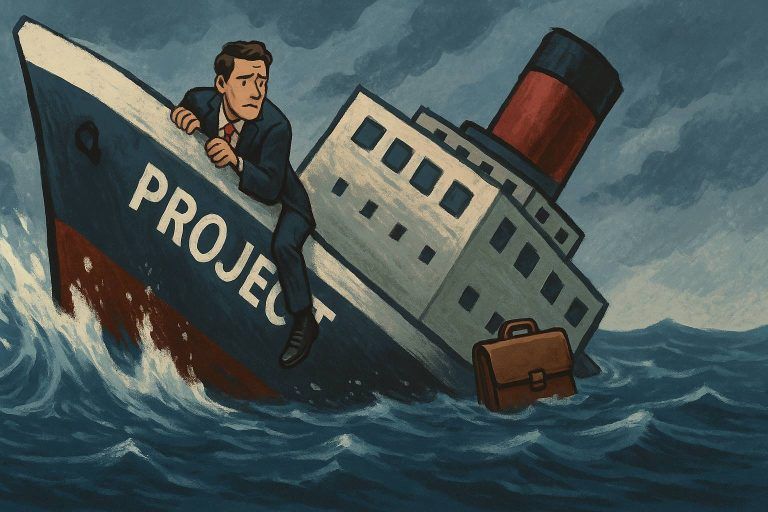Have you ever seen a company stubbornly stick to a failing project, even when it’s obvious it’s not working? Or perhaps you’ve experienced hesitation in making a decision because the stakes felt too high and the risks too great? Then you’ve either witnessed—or lived through—some of the most common decision-making traps in business.
Psychological mechanisms influence us more than we like to admit, especially when we face choices with economic or strategic consequences. Leaders, entrepreneurs, and employees alike are vulnerable. Even the most seasoned professionals can fall into irrational thinking patterns. In this article, we’ll explore four classic decision-making traps and how they can affect business operations.
Overconfidence: When We Think We Know Better Than We Do
When a leader or organization has experienced repeated success, it’s easy to believe that success is the result of brilliance rather than favorable circumstances. The problem is that past success doesn’t guarantee future results—and it can blind us to risk.
Example: Many tech companies have crashed because they were convinced they had the next big thing. Take Google Glass, for instance. A technological marvel, but completely unpopular with consumers. Google was so confident in the product that they ignored clear signals from people who felt uncomfortable walking around with a camera on their face.
Overconfidence doesn’t only exist at the leadership level—it can trickle down through the entire organization. I once worked for a company where the leaders had seen great success with previous ventures, made millions from acquisitions, and always seemed to come out on top. So, when they launched new products and strategies that didn’t sit right with me, I kept my concerns to myself. Surely, they knew what they were doing?
But my gut feeling turned out to be right. The new initiatives failed—precisely because success had made them blind to risk and unreceptive to critical feedback.
This happens in many organizations. The more success you’ve had, the harder it becomes to hear critical voices. And when employees don’t dare speak up, poor decisions can go unchallenged—until it’s too late.
How to avoid it:
- Data over gut feeling
Use market research, testing, and external evaluations before making major decisions. - Play devil’s advocate
Encourage critical thinking within the team and challenge your own assumptions. - Create a culture of openness
Ensure employees don’t feel that the company’s success story makes it impossible to question decisions. The best ideas often come from those with fresh perspectives. - Bring in external experts
People outside your organization can often spot weaknesses that internal teams may miss.
I learned a lot from that experience. It showed me how success stories can make leaders less open to critique—and employees more hesitant to speak up. And when no one dares to ask the tough questions, decisions are made in a vacuum.
Would it have made a difference if I had spoken up back then? Maybe. Maybe not. But more importantly, I learned how dangerous it is to let assumptions dictate who we listen to—and who we ignore. And just as important: how our communication style can determine whether others feel safe to speak up.
This doesn’t just apply in business—we often trust confident answers, whether they come from a leader, a colleague, or AI. I’ve personally tested how AI can sound convincing, yet be completely wrong. Read more about that here: AI in the Writing Process – Why You Should Always Fact-Check.
Playing Devil’s Advocate Isn’t Being Difficult – It’s Caring
Being the devil’s advocate isn’t something I do to be difficult. It’s just how I think. I naturally look for weaknesses in arguments, ask questions, and challenge assumptions—not to oppose, but to strengthen.
But I’ve learned that not everyone sees it that way. Some interpret it as negativity or resistance. And I get that. Because it’s not just about what you say—it’s about how and when you say it.
I know I’m not alone. Many people with an analytical or critical mindset find themselves misunderstood, especially in environments with low psychological safety. And that’s where psychology comes in: Research by Amy Edmondson at Harvard Business School shows that psychological safety is essential for people to feel comfortable asking questions, sharing ideas, and speaking up—without fear of being labeled “difficult.”
Without that safety, even constructive input can feel like an attack. This applies in leadership teams, project groups—and everyday conversations.
Key takeaway: If you’re someone who naturally challenges ideas—whether by personality, role, or reflex—remember that safety and clarity are key. When people understand that you challenge because you care, not because you’re opposed, it opens the door to better decisions and deeper trust.
Sources: Amy Edmondson, Harvard Business School. See also Google’s “Project Aristotle,” which found that psychological safety was the single most important factor in high-performing teams.
Sunk Cost Fallacy: Holding On to Bad Decisions
Have you ever kept watching a boring movie just because you’d already spent an hour on it? In business, this is known as the sunk cost fallacy—the idea that we should continue with something because we’ve already invested time, money, or pride in it.
Example: The founder who refuses to shut down a product, even though it loses money month after month. It was their first idea—their “baby”—and surely it could work with just one more marketing push? Sometimes, the right thing to do is cut your losses and move on.
We see the same pattern in everyday life. Say you’re trying to sell your car. You’ve invested in new tires, had it serviced, maybe even paid for expensive repairs. So when the first offer comes in—30,000 kroner below asking price—you decline. That’s way too low! You decide to wait for a better deal. But while you wait, the car loses even more value. A year later, you have to sell it for 90,000 less than what you hoped. And you think: Why didn’t I just accept that first offer?
This trap snares both business owners and private individuals. We let our past investments influence our current decisions—instead of focusing on what makes the most sense going forward.
How to avoid it:
- Set clear success metrics
Define what success looks like—and be willing to scrap the plan if it doesn’t deliver.
- Separate emotion from business
A business isn’t about proving you were right. It’s about creating value and generating results.
- Use a “pre-mortem” strategy
Ask yourself: If this fails in a year, what went wrong? And then—Can I address that now?
Decision Paralysis: When Too Much Information Blocks Action
The more complex a decision is, the harder it becomes to make. It’s a known psychological mechanism: when the brain is overwhelmed, we postpone decisions in hopes of gaining more clarity. But sometimes, not deciding is the worst thing you can do.
Example: A company considers changing its pricing strategy but fears the consequences. They analyze data, run simulations, bring in consultants—but never make a decision. Meanwhile, they lose market share to a competitor that acts faster.
How to avoid it:
- Set a decision deadline
Don’t let decisions drag on for months. Set a realistic deadline and act based on the best information you have at the time. - Apply the “good enough” principle
Some decisions require perfection—but most don’t. 80% right now is often better than 100% too late. - Delegate
Trust your team to make decisions. Not everything needs to go through top leadership.
Also read: Why “Perfect” Can Be the Enemy of “Good.”
Falling in Love with Your Own Idea: When the Heart Leads the Head
Entrepreneurs and business leaders often form deep attachments to their own ideas. That’s natural—you’ve invested time, energy, maybe even your own money. The problem arises when proving you’re right becomes more important than doing what’s best for the business.
Example: Kodak—yes, the company that invented the digital camera. But they refused to invest in it, clinging instead to their film business. As a result, they were outpaced by competitors and eventually filed for bankruptcy.
How to avoid it:
- Get outside feedback
Invite people outside your inner circle to assess the idea objectively. - Test before you invest
Run small pilots before going all-in. - Be open to change
The best companies are the ones that can pivot quickly when the market demands it.
Conclusion: Avoiding Decision Traps – In Business and in Life
Decisions are rarely purely logical. Psychological mechanisms play a much bigger role than we’d like to believe. Overconfidence, sunk cost fallacy, decision paralysis, and emotional attachment to our own ideas can all lead us astray—whether we’re leaders or private individuals.
To make better decisions in business, it helps to:
- Trust data and facts over gut feelings
- Be willing to cut your losses
- Make decisions fast enough to stay relevant
- Accept that change is necessary
But this applies outside the boardroom, too. These same mechanisms show up in our everyday lives: Should you cancel that subscription you never use? Sell the boat you secretly know you won’t touch next summer? Let go of that project that once gave you purpose, but now mostly brings guilt?
These decisions often feel emotional—because they are. But that’s exactly when we need clarity, not stubbornness.
Also read: 5 Methods for Making Decisions You (Probably) Won’t Regret.
Leaders who understand how the brain tricks them have a real competitive advantage. But so do all of us. When we learn to recognize these mental traps—and challenge them—we make better choices. Whether it’s about products, projects, relationships, or those guilt-inducing “someday” plans.
So the next time you’re facing a big decision: Is it your head leading—or your heart?
Have you experienced any of these decision-making traps—at work or in your personal life? Share your experiences in the comments. Maybe we’ll learn more from each other than from the theories.





